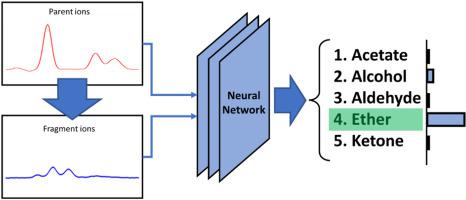Analytica Chimica Acta ( IF 6.2 ) Pub Date : 2023-03-03 , DOI: 10.1016/j.aca.2023.341047 P.E. Fowler , T. Bernat , J.Z. Pilgrim , G.A. Eiceman

|
A spectral library of field induced fragmentation (FIF) spectra for 45 oxygen-containing volatile organic compounds from 5 chemical classes was obtained using tandem differential mobility spectrometry (DMS). Protonated monomers were mobility isolated in a first DMS stage, fragmented with electric fields >10,000 V/cm in a middle (or reactive) stage, and mobility characterized in a second DMS stage. Other spectral libraries were obtained for protonated monomers and for complete mobility spectra from a single DMS stage. Neural networks from Python/Tensorflow software, prepared in-house, and from commercial NeuralWorks Professional II/PLUS were trained to assign spectra into a chemical class. The success at classification was determined for familiar and unfamiliar spectra from these three libraries. Classification test scores were best with FIF spectra with >0.99 for familiar compounds and 0.52 for unfamiliar compounds and were consistent with neural network learning of structural information from fragment ions when compared to other spectral libraries. Radar charts are introduced as measures of classification and as a tool to explore mis-classification. This work shows that ion fragmentation with multi-stage tandem DMS portends molecular identification with the portability and robustness of ambient pressure ion mobility analyzers.
中文翻译:

挥发性有机化合物迁移率谱的神经网络分类使用串联微分迁移率光谱法和场致碎裂
使用串联差分迁移率光谱法 (DMS) 获得了来自 5 个化学类别的 45 种含氧挥发性有机化合物的场致碎裂 (FIF) 光谱的光谱库。质子化单体在第一个 DMS 阶段被隔离,在中间(或反应)阶段用 >10,000 V/cm 的电场分裂,并在第二个 DMS 阶段表征流动性。为质子化单体和单个 DMS 阶段的完整迁移率光谱获得了其他光谱库。来自内部准备的 Python/Tensorflow 软件和商业 NeuralWorks Professional II/PLUS 的神经网络经过训练,可以将光谱分配到化学类别中。分类的成功取决于来自这三个库的熟悉和不熟悉的光谱。分类测试分数最好的是 FIF 谱图,熟悉的化合物 > 0.99,不熟悉的化合物为 0.52,与其他谱库相比,与碎片离子的结构信息的神经网络学习一致。引入雷达图作为分类度量和探索错误分类的工具。这项工作表明,使用多级串联 DMS 进行的离子碎裂预示着分子鉴定具有环境压力离子淌度分析仪的便携性和稳健性。


























 京公网安备 11010802027423号
京公网安备 11010802027423号